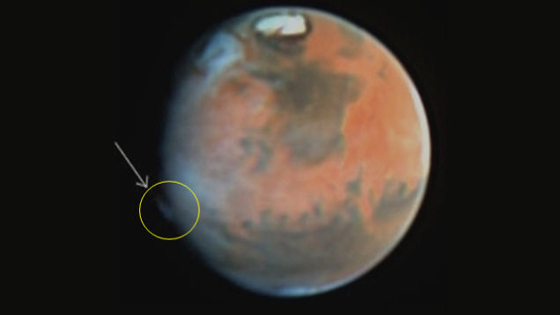Mars has bizarre plumes that scientists can’t explain. IT AWAKENS.

Oh, we have done it now. All our fucking around on Mars has awoken It. And it’s beginning to vent its Hate-Force, before rising up out of the Martian sands.
An international network of amateur astronomers has spotted what looks like two plumes, or slender, cloudy projections, extending from the surface of Mars, and their professional counterparts have no clear idea of what they might be.
“Any explanation we can think of challenges our understanding of the upper atmosphere of Mars,” says Agustín Sánchez-Lavega, a professional astronomer at the University of the Basque Country, in Bilbao, Spain, and lead author of a report on the phenomenon in the journal Nature.
“The fact that it was seen by multiple observers suggests pretty strongly that it’s real,” says Bruce Jakosky, of the University of Colorado, Boulder, principal investigator for the Mars Atmosphere and Volatile Evolution Mission (MAVEN), which is currently orbiting the red planet. “But I find the observation puzzling.” Jakosky was not involved in the research.
The plumes were first picked up in March and April 2012 by Wayne Jaeschke, a patent attorney based in West Chester, Pennsylvania, who moonlights, so to speak, as a member of the Association of Lunar and Planetary Observers (APOL). “I sent a couple of frames to some guys I know in Australia,” he says, “and asked, ‘Am I seeing things?'” The fuzzy patch of faint light, he reasoned, might have been some sort of flaw in his camera’s sensor.
But Jaeschke’s Australian counterparts saw the blurry spot too. “It looked like some strange kind of cloud,” he says, and when they alerted still more amateurs in France, they were able to spot it as well. A message went out on the group’s email list, which Sánchez-Lavega monitors.
Like many full-time astronomers, he knows that skilled amateurs often pick up celestial phenomena the pros might miss. Amateurs have been the first to see some supernovae and comets, for example, and in 2009, an Australian amateur named Anthony Wesley watched as a comet smacked into Jupiter.
Amateurs have even spotted a cloud rising from the edge of Mars once before, says Sánchez-Lavega. Spacecraft and large ground-based telescopes have seen it happen many times. The big difference here is altitude: All of those other clouds, which have been made of dust or ice particles, have never risen more than 60 miles (100 kilometers) above the surface.
The mystery clouds, however, reached more than twice as high, and persisted for ten days. “It’s hard to see how particles would get up that high,” says Jakosky. And even if they did, he says, “there are winds at these altitudes, and I would expect that they would redistribute or dissipate a cloud relatively quickly.”
Sánchez-Lavega and his co-authors (who include Jaeschke and three other amateurs, along with several professionals) agree, admitting inNature that the dust hypothesis is “difficult to support.” Another explanation the authors suggest is that the amateur astronomers had photographed an aurora, something like the northern lights on Earth. But they acknowledge that such a thing would have to be improbably bright to be seen from Earth. The plumes, of course, are long gone, so there’s no way to study them in search of an explanation.
The astronomers’ only hope is that the phenomenon will happen again. “We just have to keep watching [the planet’s edge] with telescopes on Earth and with spacecraft,” says Sánchez-Lavega. “And because they’re so numerous, so widely spread around Earth, and so dedicated,” he says, “amateurs will continue to play a fundamental role.”
The Universe is fucking awesome, and its never more fucking awesome than when it is proving We don’t know Much.



